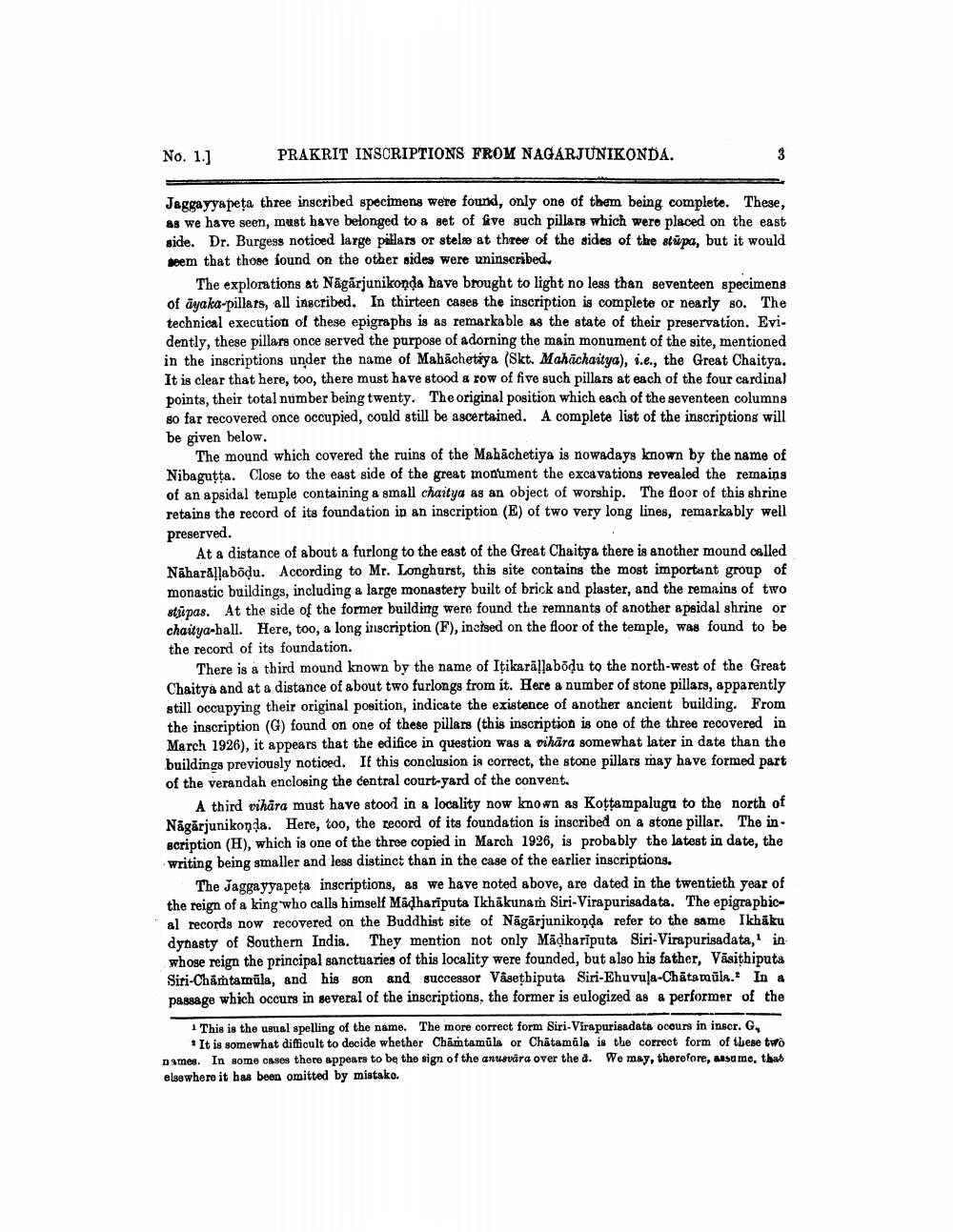________________
No. 1.]
PRAKRIT INSCRIPTIONS FROM NAGARJUNIKONDA.
Jaggayyapeta three inscribed specimens were found, only one of them being complete. These, As we have seen, must have belonged to a set of five such pillars which were placed on the east side. Dr. Burgess noticed large påklars or stelæ at three of the sides of the stúpa, but it would seem that those found on the other sides were uninscribed.
The explorations at Nägārjunikonda have brought to light no less than seventeen specimens of āyaka-pillars, all inscribed. In thirteen cases the inscription is complete or nearly so. The technical execution of these epigraphs is as remarkable as the state of their preservation. Evi. dently, these pillars once served the purpose of adorning the main monument of the site, mentioned in the inscriptions under the name of Mahāchetiya (Skt. Mahachaitya), i.e., the Great Chaitya. It is clear that here, too, there must have stood a row of five such pillars at each of the four cardinal points, their total number being twenty. The original position which each of the seventeen columns so far recovered once occupied, could still be ascertained. A complete list of the inscriptions will be given below.
The mound which covered the ruins of the Mahāchetiya is nowadays known by the name of Nibagutta. Close to the east side of the great monument the excavations revealed the remains of an apsidal temple containing a small chaitya as an object of worship. The floor of this shrine retains the record of its foundation in an inscription (E) of two very long lines, remarkably well preserved.
At a distance of about a furlong to the east of the Great Chaitya there is another mound called Nāharăllabödu. According to Mr. Longhurst, this site contains the most important group of monastic buildings, including a large monastery built of brick and plaster, and the remains of two stūpas. At the side of the former building were found the remnants of another apsidal shrine or chaitya-ball. Here, too, a long inscription (F), incised on the floor of the temple, was found to be the record of its foundation.
There is a third mound known by the name of Iţikarällabodu to the north-west of the Great Chaitys and at a distance of about two furlongs from it. Here a number of stone pillars, apparently still occupying their original position, indicate the existence of another ancient building. From the inscription (G) found on one of these pillars (this inscription is one of the three recovered in March 1926), it appears that the edifice in question was & vihara somewhat later in date than the buildings previously noticed. If this conclusion is correct, the stone pillars may have formed part of the verandah enclosing the central court-yard of the convent.
A third vihara must have stood in a locality now known as Kottampalugu to the north of Nägärjunikonda. Here, too, the record of its foundation is inscribed on a stone pillar. The inscription (H), which is one of the three copied in March 1926, is probably the latest in date, the writing being smaller and less distinct than in the case of the earlier inscriptions.
The Jaggayyapeta inscriptions, as we have noted above, are dated in the twentieth year of the reign of a king who calls himself Madhariputa Ikhākunam Siri-Virapurisadata. The epigraphical records now recovered on the Buddhist site of Nāgārjunikonda refer to the same Ikhāku dynasty of Southern India. They mention not only Madhariputa Siri-Virapurisadata, in whose reign the principal sanctuaries of this locality were founded, but also his father, Väsithiputa Siti-Chāṁtamüla, and his son and successor Våsetbiputa Siri-Ehuvula-Chatamūla. In a passage which occurs in several of the inscriptions, the former is eulogized as a performer of the
1 This is the usual spelling of the name. The more correct form Siri-Virapurisadats ocours in inscr. G.
It is somewhat difficult to decide whether Chamtamüls or Chātamala is the correct form of these two Dames. In some cases there appears to be the sign of the anusvāra over the a. We may, therefore, assame, that elsewhere it has been omitted by mistake.




